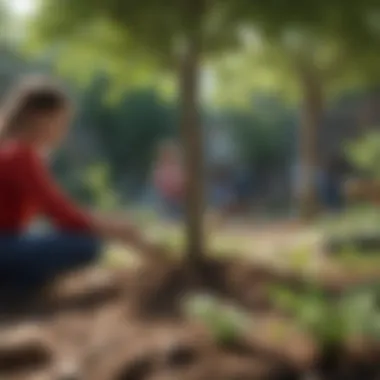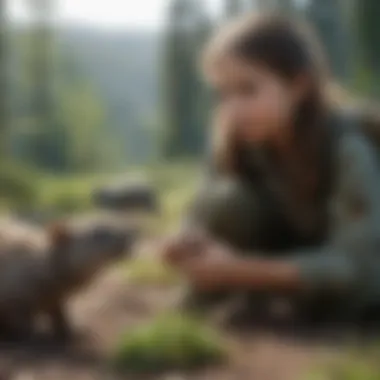Engaging Kids in Earth Day Activities


Nature Topic Overview
Earth Day is an opportunity for everyone to think about the environment and our role in protecting it. This day, celebrated every year on April 22, serves as a reminder of the delicate balance of nature. It encourages individuals, especially children, to take part in conserving our planet. Learning about ecosystems, species, and sustainability is essential. Children are empowered to understand their impact and discover how small actions can lead to significant changes.
Actions taken on Earth Day can inspire ongoing efforts throughout the year. This guide aims to provide practical actions designed for children and their families to raise awareness for environmental issues.
Fun Facts and Trivia
Here are some interesting facts about the environment:
- Over 1 million species are currently threatened with extinction.
- Trees help clean air by absorbing carbon dioxide and releasing oxygen.
- The Great Barrier Reef is the largest living structure on Earth, visible from space.
These facts are not only fascinating but also serve as a basis for discussions about why protecting the environment is vital. Visual elements, such as infographics or short videos, can make learning more engaging for young readers.
"The future will be green, or not at all."
Wildlife Explorations
Different species play crucial roles in their habitats. For instance, bees pollinate plants, essential for food production. Furthermore, large mammals like elephants help maintain a healthy ecosystem through seed dispersal. Understanding these connections fosters a love for nature among children.
Interactive features such as quizzes can enhance this section. For example:
- What animal is known as nature's gardener?
- Name three types of trees that can be found in your local area.
Encouraging children to research local species adds a personal touch to their learning. They can visit parks or gardens, observe, and document different plants and animals.
Environmental Awareness
Conservation is critical. Children should recognize that their actions contribute to the larger environmental picture. Engaging in simple acts, such as recycling, saving water, or reducing plastic usage, can make an impact.
Here are some tips to protect nature:
- Turn off lights when not in use.
- Use reusable bags while shopping.
- Plant a tree or a small garden.
Teaching children the significance of these practices shapes responsible adults who care for the planet.
DIY Nature Activities
Hands-on activities help solidify understanding. Children can create their own bird feeders using simple materials. Here’s a straightforward guide:
- Gather a toilet paper roll, peanut butter, and birdseed.
- Spread peanut butter over the roll.
- Roll in birdseed until well covered.
- Hang it on a tree branch using string.
This activity not only supports wildlife but also offers a connection to nature.
Outdoor explorations could include nature walks where children can collect leaves and learn about different plants. Each of these activities adds to their learning experience.
Significance of Earth Day
Understanding the significance of Earth Day is crucial for both children and adults. It serves as a reminder of the environmental challenges we face and emphasizes the importance of sustainability. Earth Day is not only a celebration of our planet but also a call to action. Engaging with this day can instill a sense of responsibility towards the environment among young learners. By recognizing Earth Day, individuals contribute to a larger movement that aims to protect our natural resources.
Historical Background
Earth Day has a rich history that dates back to 1970. The idea was conceived by U.S. Senator Gaylord Nelson as a response to increasing pollution and environmental degradation. On April 22 that year, millions of Americans gathered to demonstrate their support for environmental protection. This movement paved the way for significant legislative changes, including the establishment of the Environmental Protection Agency (EPA) and the passing of the Clean Air Act.
Over the years, Earth Day has grown from a national event to a global phenomenon. It now involves over one billion people in more than 190 countries. This historic background illustrates how collective efforts can lead to substantial changes and raise awareness about crucial environmental issues.
Global Impact
The impact of Earth Day transcends borders and cultures. It encourages collaboration among nations to tackle climate change, habitat destruction, and other environmental crises. Each year, specific themes guide the focus of Earth Day activities, ranging from climate action to biodiversity preservation. These themes help to rally support for pressing issues and create a sense of unity.
Examples of global initiatives include the Great Global Cleanup and the Earth Day Network, which promote sustainable practices worldwide.
"Earth Day is a reminder that we can all make a difference, one small act at a time."


By participating in Earth Day activities, individuals contribute to a broader cultural shift towards environmental accountability. For children, learning about these global impacts helps them understand their own role in fostering a sustainable future. It highlights that individual contributions to conservation can lead to meaningful change.
Personal Actions to Consider
Understanding personal actions for Earth Day is vital. It helps individuals recognize their influence on the environment. Engaging in sustainable practices can lead to a healthier planet. Teaching children about these actions empowers them to take responsibility from a young age. Not only does this foster a sense of stewardship, but it also creates habits that can last a lifetime.
Reduce, Reuse, Recycle
The concept of reducing, reusing, and recycling is foundational in promoting sustainability.
- Reduce means using less of something. This can apply to plastic bottles, paper, and energy. For instance, instead of using a new plastic bag every time, bringing a reusable bag is an effective way to reduce waste.
- Reuse involves finding new ways to use old items. Children can turn glass jars into storage containers or create art from scrap materials. This not only saves money but also reduces the need to buy new products.
- Recycle is the process of converting waste into new materials. Communities often provide recycling bins. Teaching kids how to sort their waste properly is essential.
Promoting these habits can significantly reduce landfill contributions. \nBy practicing reducing, reusing, and recycling, families can inspire their communities as well.
Sustainable Transportation
Transportation contributes significantly to greenhouse gas emissions. Choosing sustainable options can make a difference.
- Walking or Biking: For short distances, walking or biking is an effective choice. It promotes health and reduces carbon footprints. It is also a chance for families to spend quality time together.
- Public Transport: Using buses or trains helps reduce the number of individual cars on the road. Many cities offer discounts for families using public transport on Earth Day.
- Carpooling: If families need to use cars, sharing rides can minimize emissions. This is a fun way for children to connect with friends.
Teaching children about these options can encourage them to think critically about transportation choices in the future.
Energy Conservation at Home
Conserving energy at home is another crucial action for Earth Day. It not only helps the planet but also saves money.
- Turn Off Lights: Encourage children to switch off lights when leaving a room. Not only does it save electricity, but it also cultivates awareness about energy usage.
- Use Energy-Efficient Bulbs: Replacing regular bulbs with LED bulbs can reduce energy consumption. These bulbs last longer and use less power.
- Adjust Thermostat: Setting the thermostat a few degrees lower in winter and a bit higher in summer can save energy as well. Explain to kids how simple adjustments can contribute to the bigger picture.
By understanding energy conservation, children learn the importance of their role in fighting climate change.
"Every little action counts. Inspire the next generation to create sustainable habits that can lead to a significant impact on our planet."
Engaging in these actions not only benefits the environment but also provides valuable lessons for young learners and their families.
Outdoor Activities for Earth Day
Outdoor activities are a vital way to connect with nature and understand environmental issues. They allow children and adults to engage actively with their surroundings. Exploring the outdoors promotes appreciation for the environment and highlights the importance of conservation. On Earth Day, participating in these activities can lead to lasting habits that benefit both individuals and the planet.
Nature Walks and Exploration
Nature walks provide an excellent opportunity to learn about local flora and fauna. As families or groups explore parks or hiking trails, they can observe and discuss various species. This kind of exploration encourages curiosity and respect for living things. Observing wildlife helps children understand ecosystems. Simple actions, like noting the different plants or animals, can spark interest in broader environmental themes.
- Benefits of Nature Walks:
- Increases awareness of biodiversity.
- Enhances physical health through exercise.
- Fosters teamwork and communication.
Moreover, educators can suggest topics during walks—habitat loss, pollution effects, and climate change. Children can participate actively by helping to identify plants or taking notes in a nature journal. Connecting these experiences with environmental education can deepen understanding.
Planting Trees and Gardens
Planting trees and gardens has direct benefit not only for the planet but also for communities. Trees absorb carbon dioxide and provide oxygen. Community gardens offer food, promote teamwork, and beautify spaces. Engaging children in gardening teaches responsibility and patience. It's a chance to showcase how our actions directly impact the environment.
- Ways to Get Involved:
- Organize a community tree-planting event.
- Start a small garden at home or school.
- Use native plants to promote local ecosystems.
Children can learn where food comes from and the impact of pesticides and fertilizers. Educational programs can incorporate science, nutrition, and responsibility through gardening activities.
Community Clean-Up Initiatives
Participating in clean-up initiatives reinforces the idea that everyone can make a difference. These events foster a sense of pride and ownership over local spaces. When children see the immediate impact of their work, it solidifies the understanding of environmental stewardship.
- How to Organize Clean-Up:
- Partner with local organizations to find clean-up locations.
- Set a date and time that works for participants.
- Provide necessary supplies like bags and gloves.


Community clean-ups not only improve the environment but also help to build community ties. Through collaboration, children learn teamwork and the importance of contributing to society.
Engaging in outdoor activities on Earth Day fosters a deeper connection with the environment, educates about sustainability, and empowers individuals to take responsibility for their local communities.
These activities offer hands-on learning experiences that can resonate with children for years to come. Emphasizing these outdoor actions during Earth Day encourages a lifelong commitment to environmental stewardship.
Educational Endeavors
Educational endeavors related to Earth Day play a vital role in fostering a deeper understanding of environmental issues among children and adults alike. Engaging in such activities not only enriches knowledge but also cultivates a sense of responsibility toward the planet. This section highlights two critical aspects: learning about local ecosystems and participating in citizen science projects. Both of these endeavors can ignite curiosity while demonstrating how individual actions contribute to broader environmental impacts.
Learning About Local Ecosystems
Understanding local ecosystems is fundamental for developing environmental consciousness. Learning about biodiversity, habitats, and the relationships between species can encourage appreciation for nature. Consider organizing a field trip to a nearby park, nature reserve, or even your backyard. Observing plants, animals, and insects in their natural habitat provides firsthand experience that enhances learning.
Here are some activities to deepen this understanding:
- Nature Scavenger Hunt: Create a list of local plants, animals, and natural elements for children to find. This engages them with their environment in a fun way.
- Study Habitats: Encourage kids to investigate different habitats like ponds, forests, or gardens. Discuss what creatures live there and how each plays a role in the ecosystem.
- Talk About Conservation: Discuss the importance of protecting local ecosystems. This can include simple actions like planting native species or maintaining clean habitats.
By engaging with local ecosystems, children learn firsthand the importance of their conservation and the role they can play in protecting them.
Engaging in Citizen Science Projects
Citizen science provides an excellent opportunity for individuals, especially children, to contribute to scientific research while learning. Participating in these projects fosters collaboration and enhances problem-solving skills. These initiatives can vary widely, from tracking local bird populations to monitoring water quality in a local stream. Here are some reasons to engage in citizen science:
- Real-World Impact: Children see the direct consequences of their work on scientific communities.
- Skill Development: Engaging in scientific practices teaches valuable skills such as data collection, analysis, and teamwork.
- Community Involvement: These projects often involve partnerships with local organizations, allowing children to connect with experts and their community.
To get started, consider the following citizen science initiatives:
- Great Backyard Bird Count: Families can count the birds in their backyard and submit their findings online. This helps researchers track bird populations and migration patterns.
- Water Quality Monitoring: Join local groups that monitor water bodies. Kids can learn about local water ecosystems and what makes water clean or polluted.
- Insect Investigations: Collect data on local insect species. This often involves basic classification and recording observations, enhancing understanding of ecosystems.
Citizen science is an engaging way to learn while contributing to our understanding of the environment.
"Education is not the learning of facts, but the training of the mind to think." – Albert Einstein
Creative Projects for Kids
Engaging children in creative projects provides a hands-on approach to understanding environmental issues. These activities not only inspire imagination but also enhance critical thinking skills. Children learn about sustainability through practical methods, making the information more relatable and easier to grasp. Furthermore, when children create something from waste materials or nature, they develop a stronger connection to the environment. This connection fosters a sense of responsibility towards their surroundings and encourages conversations about the importance of conservation.
Most importantly, creative projects can be simple and enjoyable, ensuring children remain engaged. They offer an opportunity for parents, teachers, and caregivers to bond with kids while instilling valuable environmental knowledge. The following sections detail specific creative projects that children can undertake to celebrate Earth Day.
Upcycling Crafts
Upcycling crafts represent an innovative way to repurpose items that would normally be discarded. This practice not only reduces waste but also teaches children the value of creativity in sustainability. When children engage in upcycling, they learn to see potential where others may see trash. Simple items like plastic bottles, cardboard boxes, or old clothes can be transformed into functional or decorative pieces.
Here are some examples of upcycling crafts that children can explore:
- Plastic Bottle Planters: These can serve as fun pots for small plants or herbs.
- Cardboard Forts: Old boxes can be transformed into play structures that spark imagination.
- T-Shirt Tote Bags: An easy project for turning an old shirt into a reusable shopping bag.
Through these crafts, children not only enjoy the process of creating but also internalize the message of reducing waste. They learn that every material has a second chance, promoting a mindset geared toward sustainable living.
Nature Journals and Art
Nature journals offer a platform for children to observe and document their surroundings. These journals encourage mindfulness and observation skills, rich experiences fundamental to understanding ecosystems. Children can draw, write, or collect samples from nature walks, fostering a deeper appreciation for their environment.
Here are some elements children can include in their nature journals:
- Sketches of Plants and Animals: Drawing what they see enhances artistic skills and observation.
- Descriptions and Facts: Writing down interesting facts about different species helps reinforce knowledge.
- Seasonal Changes: Recording how the landscape changes over time encourages them to notice details that might otherwise go overlooked.
Moreover, integrating art into nature studies nurtures creativity. Whether through painting, collage, or poetry, the act of creating art using environmental themes helps solidify the concepts learned. Children express their feelings toward nature, which can lead to a lifetime of environmental advocacy.
"Creative projects empower children to be environmental stewards, developing attitudes of sustainability and responsibility."
In summary, engaging children in creative projects is crucial for fostering a connection with the environment. Upcycling crafts and nature journaling not only promote sustainability but also enhance learning through creativity. Parents, teachers, and caregivers play an essential role in guiding children through these experiences, ensuring that the lessons learned resonate long after Earth Day.


Promoting Environmental Advocacy
Promoting environmental advocacy is vital for cultivating a generation sensitive to ecological issues. This section emphasizes the benefits of fostering a strong environmental voice among youth. As children learn about advocacy, they become more aware of their role in the world. They can influence their families and communities to adopt sustainable practices. Education around advocacy encourages them to speak up about critical issues like climate change, pollution, and biodiversity loss.
By engaging in advocacy, children not only gain knowledge but also develop important skills. They learn to articulate their thoughts, work collaboratively, and understand the value of leadership. When young people advocate for the environment, they establish a sense of responsibility toward their surroundings. Such experiences can shape their attitudes for years to come. In this manner, we can create informed citizens who prioritize the well-being of our planet.
Understanding Environmental Issues
Understanding environmental issues forms the foundation of effective advocacy. Children should be taught about various topics, including pollution, deforestation, and climate change. Each issue presents different challenges, but they all affect the health of our planet. Education allows children to connect the dots between their actions and environmental impacts.
Here are some essential environmental issues to discuss:
- Air Pollution: Explain how industries, vehicles, and even household products release harmful substances into the air. This knowledge helps children understand the importance of clean air.
- Plastic Waste: Discuss the excess of plastic in landfills and oceans. Encourage them to recognize the importance of reducing single-use plastics.
- Climate Change: Help them grasp the concept of climate change and its long-term effects on life and ecosystems.
By equipping children with this knowledge, they will be better prepared to advocate effectively.
Leveraging Social Media for Awareness
Social media serves as a powerful platform for raising awareness. Young advocates can harness these tools to share their messages about environmental issues. Guidance from parents and teachers is essential in teaching safe and effective use of social media.
Here are some ways to leverage social media for awareness:
- Creating Awareness Campaigns: Encourage kids to start their own campaigns about topics they care about, such as tree planting or reducing plastic consumption.
- Sharing Educational Content: Teach them to share articles and videos that explain environmental issues clearly. Visual content, such as infographics and videos, tends to engage audiences more.
- Establishing Community Groups: Help them create or join online groups focused on environmental issues. These groups can provide support and resources for advocacy efforts.
By understanding how to use social media wisely, children can amplify their voices and reach broader audiences. Advocacy through digital platforms can significantly enhance the impact of their messages.
Inspiration from Global Movements
Understanding Inspiration from Global Movements enriches our awareness of how collective actions can yield powerful changes in environmental conservation. The Earth is facing unprecedented challenges such as climate change, pollution, and loss of biodiversity. These global movements showcase how young individuals and groups can lead initiatives that influence real change. They serve as a platform for learning and engagement, encouraging children and parents to participate actively in protecting their immediate surroundings.
Highlighting Young Environmental Leaders
Young environmental leaders are emerging all over the world. These kids, often passionate about conservation, inspire their peers and adults alike. They demonstrate that age is not a barrier to making a significant impact. For example, Greta Thunberg, while still a teenager, has mobilized millions to take action on climate change. Her approach revolves around simple yet powerful ideas, fundamentally changing the conversation on environmental issues.
Another prominent figure is Xiye Bastida, a young activist from Mexico. She advocates for indigenous rights and climate justice, showing that our youth can bridge gaps and draw attention to various intersecting issues affecting the planet. These leaders highlight the potential within each child; they remind us that everyone has the right and ability to advocate for a better future.
By showcasing these role models, children can see how their ideas and actions matter, fostering a sense of responsibility. It is essential to encourage discussions at home or in educational settings about these leaders and their causes.
Case Studies of Successful Initiatives
Examining successful initiatives emphasizes what can be achieved when communities harness the power of the young. For instance, the Fridays for Future movement began as a simple school strike by Greta Thunberg. It has since blossomed into an international movement involving millions of students advocating for policy changes regarding climate action.
Another significant study is the Plastic Pollution Coalition. This initiative involved children from various countries, helping to reduce plastic waste in their communities. Through engaging discussions and activities, they successfully lobbied local businesses to decrease plastic usage and promoted recycling.
Here are some key points to consider from these case studies:
- Leadership doesn’t require age; even children can lead change.
- Collective action amplifies the voice of individuals.
- Real, measurable results can come from community engagement.
In summary, the role of youth in environmental movements is vital. They inspire other children, their families, and communities to take meaningful action and address climate change. By learning about young leaders and successful initiatives, children can engage in practical actions towards a better tomorrow.
Epilogue: Continuing the Journey Beyond Earth Day
The concept of continuing the journey beyond Earth Day is crucial for fostering sustainable behavior. Earth Day serves as a catalyst for awareness, and the knowledge gained should not be confined to a single day. Instead, it must evolve into long-lasting habits and a deeper appreciation for nature. Engaging in environmental practices regularly reinforces the significance of caring for the planet.
Establishing Long-term Habits
Creating long-term habits begins with the simple actions we take daily. Individuals can work towards making sustainability a routine part of their lives. Here are some practical steps to consider:
- Reduce waste: Aim to minimize single-use products by carrying reusable bags and containers. This small change can lead to significant reductions in plastic consumption over time.
- Compost: Encourage composting at home to divert food scraps and yard waste from landfills. This not only reduces waste but also enriches the soil, promoting healthier gardens.
- Conserve water and energy: Turn off taps when not needed and switch off lights when leaving rooms. These actions contribute to resource conservation continuously.
The benefits of these habits are numerous. Regular practice fosters a sense of responsibility and connection to the environment. Children who engage in these behaviors develop a mindset geared towards sustainability from a young age.
Encouraging Family Discussions on Nature
Family discussions about nature and environmental issues can create a supportive learning environment. Here are some ways to initiate meaningful conversations:
- Share experiences: Encourage family members to discuss their outdoor adventures or favorite natural spaces. This fosters appreciation and a personal connection to the environment.
- Discuss current events: Talk about environmental issues reported in the news. It can enhance understanding and concern for local ecosystems.
- Explore together: Plan visits to parks or nature reserves as a family. Use these outings as opportunities to discuss the importance of conservation and biodiversity.
By creating a space where nature is a frequent topic, families can instill the values of environmental stewardship. These conversations can inspire children to be proactive about their actions and to recognize their impact on the world around them.
"The greatest threat to our planet is the belief that someone else will save it." - Robert Swan







